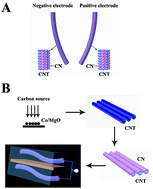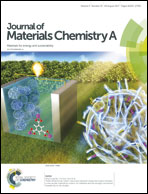Carbon nanospheres hanging on carbon nanotubes: a hierarchical three-dimensional carbon nanostructure for high-performance supercapacitors†
Abstract
We describe the single-step synthesis of carbon nanospheres hanging on carbon nanotubes (CNs/CNTs), using a simple chemical vapor deposition method. The structure of CNs/CNTs could be easily controlled. In the CN/CNT composites the CNTs have a diameter of ca. 200 nm and were cladded by carbon spheres. The TEM image displays homogeneous dispersion of the carbon spheres on the walls of CNTs which have a length of ca. 5 μm. The shape of the obtained composites is like grapes hanging in the branches which not only possess high electric conductivity for charge transport but also possess specific surface areas for accessing electrolyte ions. When using an ionic liquid electrolyte, CN/CNT-based electric double layer (EDL) supercapacitors can deliver a high specific energy of 61.2 W h kg−1 at a power density of 563.4 W kg−1. The EDL capacitor demonstrates excellent cycling performance with 92.7% capacitance retention after 10 000 cycles at a current density of 10 A g−1. The key to high performance lies in the hanging CNs for ion accumulation and the CNT backbone providing path channels for ion faster diffusion, thereby boosting both power density and energy density.


 Please wait while we load your content...
Please wait while we load your content...